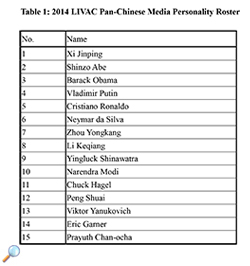2014 top personalities of Pan-Chinese news media
?
The 2014 LIVAC Pan-Chinese Media Personality Roster was released on 29 December by the Department of Linguistics and Translation of City University of Hong Kong (CityU). The roster reflects political issues dominating media coverage in Beijing, Taipei and Hong Kong. (Please refer to Table 1: 2014 LIVAC Pan-Chinese Media Personality Roster.)
The 2014 LIVAC roster lists 15 celebrities, the fewest since the 10 listed in 2010. It is dominated by political figures in mainland China, the US, Japan, Taiwan, Thailand, Russia and Ukraine. Appearing most frequently are four names from mainland China followed by three from the US. They reflect the current political ecology and indicate that power struggles among mainland China, the US and Russia, Sino-Japanese relations, and tension in Ukraine have drawn considerable media attention in the Pan-Chinese region.
“The appearance of the former PRC Politburo Standing Committee Member Zhou Yongkan on the roster shows President Xi Jinping’s determination in anti-corruption in mainland China. We are reminded of the long-standing racial tension in the US by incidents such as the death of the African-American teenager Eric Garner in the hands of the police and subsequent protests. The political instability in Thailand is also a major concern among regional news media,” said Professor Benjamin T'sou Ka-yin, Emeritus Professor of the Department of Linguistics and Translation of CityU.
The annual Pan-Chinese Media Personality Roster details the rankings in terms of total media exposure of personalities in Beijing, Hong Kong and Taipei. The results are based on cumulative statistics from the bi-weekly rosters compiled and published throughout 2014.
There have been noteworthy developments in the regional political scenes in Hong Kong, Taiwan and mainland China: The anti-corruption campaign in the mainland continues to be a prime focus of political development in the country; the Occupy Central campaign and related protests have created a significant impact on Hong Kong; the recent nine-in-one election in Taiwan has changed the political spectrum there. However, apart from Zhou Yongkan, who has been arrested, no name associated mainly with these developments has received sufficient prime media attention to gain a place on the Pan-Chinese roster. The reasons behind these differences in regional media foci are thought provoking.
In Hong Kong, popular sports and entertainment figures were a frequent focus of the media. Among them, Kim Soo-hyun, Nicholas Tse, Luis Alberto Suarez, Aaron Kwok, Faye Wong, Gem Tang, Cristiano Ronaldo were highly ranked. Despite the social impact of the Occupy Central campaign since October, no major figure in the campaign entered even the Hong Kong roster. While the unprecedented court case involving Thomas Kwok and Rafael Hui, the No. 2 man in the HKSAR government during Donald Tsang’s administration, has drawn much attention, only Thomas Kwok’s name appears on the Hong Kong roster, reflecting the difference between the media focus in Hong Kong and other Pan-Chinese regions.
In Taiwan, important political figures Ma Ying-jeou, Lien Sheng-wen, Tsai Ing-wen, and Jiang Yi-Huah continued to dominate the Taipei roster as usual. The winner of the Taipei mayoral election, Ko Wen-je, ranked second in the roster, appeared for the first time. The 2014 Taipei Metro attack by the 21-year-old university student Cheng Chieh, ranked No. 9, also aroused media attention. The Taiwan actor and singer Kai Ko is ranked 18th for drug abuse in Beijing.
Five of the seven new Politburo Standing Committee members entered the Beijing roster this year. The mainland’s First Lady, Peng Liyuan, as well as cabinet members Li Zhanshu and Wang Huning are highly ranked in the Beijing roster. The head of CPC anti-graft commission, Wang Qishan, is ranked 44th, which is also of interest.
Launched by CityU in 1995, the LIVAC (www.LIVAC.org) Synchronous Corpus regularly and concurrently filters and rigorously analyses data from newspapers in major Chinese communities. More than 550 million characters of news media text have been processed and analysed, building an expanding Pan-Chinese dictionary of 1.7 million words. The annual Pan-Chinese Media Personality Roster was launched in 2000.
